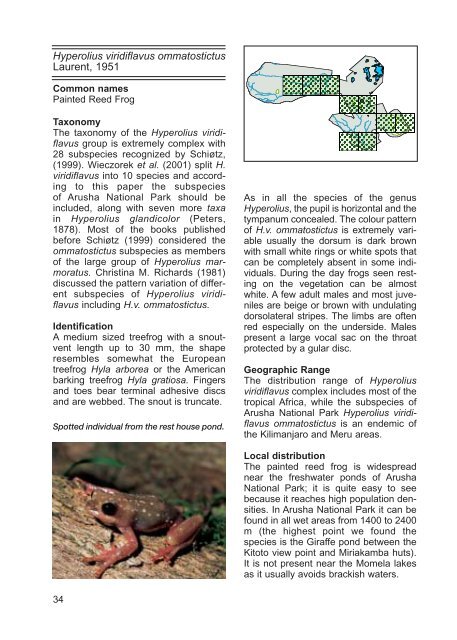field guide to the amphibians and reptiles of arusha national park
field guide to the amphibians and reptiles of arusha national park
field guide to the amphibians and reptiles of arusha national park
Create successful ePaper yourself
Turn your PDF publications into a flip-book with our unique Google optimized e-Paper software.
Hyperolius viridiflavus omma<strong>to</strong>stictus<br />
Laurent, 1951<br />
Common names<br />
Painted Reed Frog<br />
Taxonomy<br />
The taxonomy <strong>of</strong> <strong>the</strong> Hyperolius viridiflavus<br />
group is extremely complex with<br />
28 subspecies recognized by Schiøtz,<br />
(1999). Wieczorek et al. (2001) split H.<br />
viridiflavus in<strong>to</strong> 10 species <strong>and</strong> according<br />
<strong>to</strong> this paper <strong>the</strong> subspecies<br />
<strong>of</strong> Arusha National Park should be<br />
included, along with seven more taxa<br />
in Hyperolius gl<strong>and</strong>icolor (Peters,<br />
1878). Most <strong>of</strong> <strong>the</strong> books published<br />
before Schiøtz (1999) considered <strong>the</strong><br />
omma<strong>to</strong>stictus subspecies as members<br />
<strong>of</strong> <strong>the</strong> large group <strong>of</strong> Hyperolius marmoratus.<br />
Christina M. Richards (1981)<br />
discussed <strong>the</strong> pattern variation <strong>of</strong> different<br />
subspecies <strong>of</strong> Hyperolius viridiflavus<br />
including H.v. omma<strong>to</strong>stictus.<br />
Identification<br />
Amedium sized treefrog with a snoutvent<br />
length up <strong>to</strong> 30 mm, <strong>the</strong> shape<br />
resembles somewhat <strong>the</strong> European<br />
treefrog Hyla arborea or <strong>the</strong> American<br />
barking treefrog Hyla gratiosa. Fingers<br />
<strong>and</strong> <strong>to</strong>es bear terminal adhesive discs<br />
<strong>and</strong> are webbed. The snout is truncate.<br />
Spotted individual from <strong>the</strong> rest house pond.<br />
34<br />
As in all <strong>the</strong> species <strong>of</strong> <strong>the</strong> genus<br />
Hyperolius,<strong>the</strong> pupil is horizontal <strong>and</strong> <strong>the</strong><br />
tympanum concealed. The colour pattern<br />
<strong>of</strong> H.v. omma<strong>to</strong>stictus is extremely variable<br />
usually <strong>the</strong> dorsum is dark brown<br />
with small white rings or white spots that<br />
can be completely absent in some individuals.<br />
During <strong>the</strong> day frogs seen resting<br />
on <strong>the</strong> vegetation can be almost<br />
white. A few adult males <strong>and</strong> most juveniles<br />
are beige or brown with undulating<br />
dorsolateral stripes. The limbs are <strong>of</strong>ten<br />
red especially on <strong>the</strong> underside. Males<br />
present a large vocal sac on <strong>the</strong> throat<br />
protected by a gular disc.<br />
Geographic Range<br />
The distribution range <strong>of</strong> Hyperolius<br />
viridiflavus complex includes most <strong>of</strong> <strong>the</strong><br />
tropical Africa, while <strong>the</strong> subspecies <strong>of</strong><br />
Arusha National Park Hyperolius viridiflavus<br />
omma<strong>to</strong>stictus is an endemic <strong>of</strong><br />
<strong>the</strong> Kilimanjaro <strong>and</strong> Meru areas.<br />
Local distribution<br />
The painted reed frog is widespread<br />
near <strong>the</strong> freshwater ponds <strong>of</strong> Arusha<br />
National Park; it is quite easy <strong>to</strong> see<br />
because it reaches high population densities.<br />
In Arusha National Park it can be<br />
found in all wet areas from 1400 <strong>to</strong> 2400<br />
m (<strong>the</strong> highest point we found <strong>the</strong><br />
species is <strong>the</strong> Giraffe pond between <strong>the</strong><br />
Ki<strong>to</strong><strong>to</strong> view point <strong>and</strong> Miriakamba huts).<br />
It is not present near <strong>the</strong> Momela lakes<br />
as it usually avoids brackish waters.

















